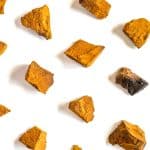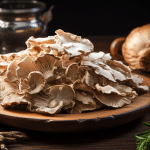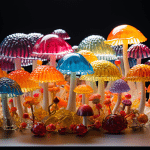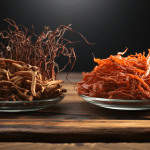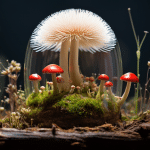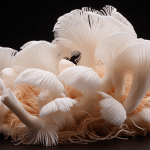What Are Black Trumpet Mushrooms?
Black trumpet mushrooms are a type of edible wild mushroom. Its Latin name is Craterellus cornucopioides. It is known also in various other names throughout the world. Some people call it a “horn of plenty or many heads” mushroom. This is a reference to acornucopia.
A cornucopia is an arrow that represents plenty, which comes from Greek mythology. According to legend, it would fill up on any food or drink requested by its owners. The black trumpet mushroom is called “trumpet of the dead” in many cultures as well, which is pretty intense.
The French refer to it as “la trompette de mort” while Italians refer to it as the “trombetta dei morti”. The name has nothing to do with the mushrooms being toxic, as they are non-toxic and are indeed edible. Rather, the mushrooms were imagined to be pipes played under the earth by the dead. In Haiti, the mushrooms were called djondjon.
Where Do Black Trumpet Mushrooms Grow? When Can You Find Them?
This type of black mushrooms grows in hardwood forests. They particularly like to grow close to broad-leaved trees such as beech or oak. Although black trumpet mushrooms do not directly fruit on live or dead wood, they grow close to it. You’ll frequently find black trumpet mushrooms growing directly on tree bases.
You can find black trumpet mushrooms growing in the wild throughout North America, Europe, and Asia. Within Europe, they are prevalent in certain countries, such as the UK. Meanwhile, they are fairly uncommon in others, such as the Netherlands.
Like most mushrooms, black trumpets like to grow in dark, dank places. Black trumpet mushrooms are frequently found in areas with moss, which is a good indication of the presence of lots of humidity. Looking for mushrooms in mossy areas can make them easier to spot as well.
Their black color is more pronounced when contrasted with green moss. Against leaf litter on a forest floor, it is harder to spot the trumpet mushrooms due to their darker color.
Trumpet mushrooms also tend to grow in areas that have high lime or calcium levels. So looking for areas near lime deposits, or those with white-colored soils, will help, too. Finally, look in areas that are marshy, near small streams or other sources of water.
This will increase the chances that you can spot these mushrooms as well. Increase the chances of finding black trumpet mushrooms by looking down, walking slowly.
You need to be mostly directly on top of them, otherwise it is very easy to miss. At first sight, they might seem more like holes in the ground than mushrooms. Once you have found one of these single black trumpet mushrooms, carefully inspect the area.
They tend to grow in clusters. So, where one is, more may be close by.
When To Forage for Black Trumpet Mushrooms
In England, black trumpet mushrooms are found in the wild from August to November. In North America, the black trumpet seasons vary depending on if you live on the East Coast or West Coast. West Coast black trumpet mushrooms are grown during the winter months. From November to early March.
Black trumpet mushrooms on the eastern shore grow more in summer. From mid-July to late August.
There is a bit of debate within the mushroom community as to whether or not these mushrooms from the different coasts are of the same species, or are distinctly different. Some refer to the eastern variation as being its own species. It is called Craterellus fallax in order to differentiate it from the Western variant.
More On How Black Trumpet Mushrooms Grow
One of the things that is interesting about black trumpet mushrooms is that they appear to be both mycorrhizal and saprophytic. That means that they grow around trees in particular species, as well as occasionally living on decomposing material.
Most mushrooms generally work only in one of these ways. You will usually find black trumpet mushrooms growing in the same areas that also have chanterelle mushrooms. So, you may find yourself looking at several different species of mushrooms all at once.
What Do Black Trumpet Mushrooms Look and Feel Like?
Black trumpet mushrooms are fairly easy to identify. They are shaped like a funnel, and can vary in colour from black, grey, or brown.
The Cap
The top is vase-shaped, with waved edges rolling outward. The bottom side of a black trumpet mushrooms cap is smooth or lightly wrinkled. It has no gills, teeth, or pores.
Stem Qualities
The stem of black trumpet mushrooms grows to 4 inches (10 cm) high. The stem is either as dark as the cap, or a little lighter. The stem is hollow and very thin, easily broken by fingers.
Texture and Feel
The texture of the black trumpet mushrooms is a mushy one. They feel almost like suede-like materials due to the smooth surfaces.
Spore Print Characteristics
You should not use the black trumpet mushrooms spore impressions as your only identification tool. The color of the mushroom spores may vary from white to pinkish. In some places, spore prints may also appear yellowish.
Some Black Trumpet Mushroom Look-Alikes
You will not find black trumpet mushrooms like this one, which are toxic. That makes them a good choice for novice mushroom hunters. While not toxic, this does not have the same flavor profile as the black trumpet. This similar plant also grows in the spring, unlike the black trumpet, which grows during the summer or fall in most areas.
Are Black Trumpet Mushrooms Rare?
Black trumpet mushrooms are not particularly rare. Not compared with other varieties of wild mushrooms, such as chanterelles or porcini. It is just their darker colors and weird shapes make them harder to spot on a forest floor.
It is easy to pass by them unnoticed unless you are looking closely. You aren’t likely to come across them unless you are looking specifically for them. Because of that, some mushroom hunters can go years without finding one.
As we mentioned before, stick to areas with lots of moss, which will add to the mushrooms contrast with the forest floor, making it easier to detect.
How To Store and Preserve Black Trumpet Mushrooms
Because black trumpet mushrooms tend to grow in patches or clumps, you are likely to come across more than you can eat straight. You will have to save a few for later. We hear that some have found 40 pounds (18 kg) or more at one site!
Fortunately, the fact that black trumpet mushrooms are hollow makes it easy for them to dry quickly. You can just let black trumpet mushrooms sit in open air, room temperature, and they will dehydrate naturally.
If they are particularly moist, you can place them in a food dehydrator or an oven set on low for a couple hours first to remove any excess moisture. You can tell that your black trumpet mushrooms are dry enough for storage when they are crumbly and easily broken, like a cracker.
At this point, you can just seal them up in a mason jar or another glass container. You can cut them up or powder them before storing, if desired. They retain their flavors pretty well if dried.
Rehydrating black trumpet mushrooms is like rehydrating any other mushrooms. Cover them with stock or hot water. Then strain to remove any duff.
How To Clean Black Trumpet Mushrooms
Cleanly picking out the black trumpet mushrooms is a challenge. However, you must clean these wild mushrooms prior to eating, otherwise, they may have a grittier texture. Not only are they fairly fragile, but because they are hollow, they tend to collect a lot of trash and soil within.
You can decrease the amount of trash you will need to clean up by not picking up your Trumpets in areas that contain pine trees, or after a big rain. Cleaning black trumpet mushrooms starts at harvest time.
Bring along a pair of scissors, and cut away any mud-covered undersides before adding them to a basket or bag. Most tools are too coarse to remove larger pieces of trash, and they will tear up your delicate mushrooms. You can use your hands to gently brush off large pieces of debris, or pick them up. We also found a silicone pastry brush to be quite gentle for this task. For especially messy piping, you can cut it in half, lengthwise.
Then, dip them gently in a little cold water. Try to do this quickly to avoid soaking up any extra liquid. After washing, lay them out to air dry on a cloth towel and let any extra moisture escape. Then, you can cook or begin your preservation process as normal.
How To Prep, Cook and Eat Black Trumpet Mushrooms
Because black trumpet mushrooms are hollow, they cook up really fast. Be careful to avoid overcooking them. They typically need just one to two minutes in the cooker, and are done.
You can prepare black trumpet mushrooms just like you would any other mushrooms, and they taste just fine. But you will miss the best way to enjoy them, in our opinion. A good recipe for black trumpet mushrooms will make sure that you are getting the most of what they have to offer.
Their intense flavors make them an excellent addition to a wide variety of recipes. You can try them in pasta dishes, seafood recipes, soups, sauces, rice, salads, or combined with just about any type of meat. You cannot go wrong pairing them with cream, either. Try to avoid especially intense flavors and spices, which may overwhelm their flavors.
Can You Cultivate Black Trumpet Mushrooms?
Black trumpet mushrooms are extremely difficult to grow and far more difficult to breed commercially. Unless you are a skilled mushroom farmer, we would recommend against this, since this is most likely only going to result in disappointment and disappointment. If you are going to attempt growing them, purchase the spores or cultures online from a reputable vendor. Be sure to follow the instructions exactly as they are provided in the packets so that you can have the best results.
Different varieties of black trumpets can need different temperatures or growing conditions. So, there is not one-size-fits-all.








